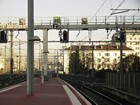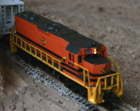
Aaaall abooooard !!!
Re: Aaaall abooooard !!!
Dreams of my reality... 

Observateur désabusé
Prince Héréditaire du Bruxelbourg et Saroulmapoul délocalisé
La Principauté s'oppose fermement à l'annexion du Koikilenkoutt. Vive le Koikilenkoutt libre
Prince Héréditaire du Bruxelbourg et Saroulmapoul délocalisé
La Principauté s'oppose fermement à l'annexion du Koikilenkoutt. Vive le Koikilenkoutt libre
-

Rockandrail - Vertueux Du Goulag
- Messages: 18622
- Âge: 72
- Enregistré le: 13 Déc 2007, 23:55
- Localisation: Royan
Re: Aaaall abooooard !!!
Pierre bis a écrit:Rapide 424 a écrit:
Tiens, les Etazuniens ont gardé les bandes jaunes sur leur route. Ets-ce général?
Non mais il y en a souvent c'est vrai.
Espère, pauvre fou, que les chaînes de la justice te saisissent avant que le glaive de ma vengeance ne te trouve.
-

Soldier of fortune - Nanomodéliste
- Messages: 2054
- Âge: 62
- Enregistré le: 13 Déc 2007, 22:31
Re: Aaaall abooooard !!!
Pourquoi ? Y en a plus en France de bandes jaunes a ne pas chevaucher ? Premiere nouvelle.... C'est vrai que je suis parti aux Tazunis en 1984 et que depuis que je suis rentre en 2005, je n'ai guere conduit en France. Mais c'est quand-mme bon asavoir. Sans bande jaune, ca veut dire qu'on peut doubler en haut des cotes ? 

- Rapide 424
- Bavard
Re: Aaaall abooooard !!!
Non. Cela veut dire que les bandes sont blanches. 

Observateur désabusé
Prince Héréditaire du Bruxelbourg et Saroulmapoul délocalisé
La Principauté s'oppose fermement à l'annexion du Koikilenkoutt. Vive le Koikilenkoutt libre
Prince Héréditaire du Bruxelbourg et Saroulmapoul délocalisé
La Principauté s'oppose fermement à l'annexion du Koikilenkoutt. Vive le Koikilenkoutt libre
-

Rockandrail - Vertueux Du Goulag
- Messages: 18622
- Âge: 72
- Enregistré le: 13 Déc 2007, 23:55
- Localisation: Royan
Re: Aaaall abooooard !!!
Les bandes sont blanches si elles sont permanentes et jaunes si elles sont provisoires (travaux) en France. Aux Usa, je ne connais pas la réglementation. C'est ce qu'on nous apprend en FCOS (formation continue obligatoire de sécurité) complément à la visite médicale pour le prolongement de validité des permis PL et TC.
- 16012
- Messages: 617
- Enregistré le: 05 Oct 2010, 15:01
Re: Aaaall abooooard !!!
Wikipedia sur les bandes jaunes/blanches US:
(En gros --Blanches : bandes de separation dans la meme direction sur autoroute. Jaunes : separant circulations inverses, simples, doubles ou pointillees.)
United States
Generally white lane markings indicate a separation between lanes traveling in the same direction while yellow markings indicate opposing traffic on the other side of the line. In some areas, such as Colorado, black material is applied on the surface before a shorter white line is painted. This improves the contrast of the marking against "white" concrete.
In California, Botts' dots are commonly used to mark lanes on most freeways. A large number of California cities also use Botts' dots on some (or all) major arterials. The notable exception is the city of Los Angeles, which cannot afford to maintain any raised lane markers due to its fiscal problems, and uses only paint.[citation needed]
In California and Nevada, the reflectors when present are usually the lines, and no paint is used for additional markings. Exceptions include: freeways built from white concrete where painted stripes are added to make the lanes more visible through sun glare, freeways built so wide that the risk of drifting is minimal (e.g., Interstate 5 in the Central Valley), and freeways in areas where it snows in the winter (since the snowplows would scrape off the Botts' Dots).
In general, single broken lines mean passing is allowed, single solid lines mean pass only to avoid a hazard, and double solid lines mean it is prohibited, as it often is in tunnels. On two-lane roads, a single broken centerline means that passing is allowed in either direction, a double solid centerline means passing is prohibited in both directions, and the combination of a solid line with a broken line means that passing is allowed only from the side with the broken line and prohibited from the side with the solid line.
(En gros --Blanches : bandes de separation dans la meme direction sur autoroute. Jaunes : separant circulations inverses, simples, doubles ou pointillees.)
United States
Generally white lane markings indicate a separation between lanes traveling in the same direction while yellow markings indicate opposing traffic on the other side of the line. In some areas, such as Colorado, black material is applied on the surface before a shorter white line is painted. This improves the contrast of the marking against "white" concrete.
In California, Botts' dots are commonly used to mark lanes on most freeways. A large number of California cities also use Botts' dots on some (or all) major arterials. The notable exception is the city of Los Angeles, which cannot afford to maintain any raised lane markers due to its fiscal problems, and uses only paint.[citation needed]
In California and Nevada, the reflectors when present are usually the lines, and no paint is used for additional markings. Exceptions include: freeways built from white concrete where painted stripes are added to make the lanes more visible through sun glare, freeways built so wide that the risk of drifting is minimal (e.g., Interstate 5 in the Central Valley), and freeways in areas where it snows in the winter (since the snowplows would scrape off the Botts' Dots).
In general, single broken lines mean passing is allowed, single solid lines mean pass only to avoid a hazard, and double solid lines mean it is prohibited, as it often is in tunnels. On two-lane roads, a single broken centerline means that passing is allowed in either direction, a double solid centerline means passing is prohibited in both directions, and the combination of a solid line with a broken line means that passing is allowed only from the side with the broken line and prohibited from the side with the solid line.
- Rapide 424
- Bavard
Re: Aaaall abooooard !!!
Bonsoir,
J'ai tout compris sauf ceci : Botts' dots : Qu'est-ce?
@+
J'ai tout compris sauf ceci : Botts' dots : Qu'est-ce?
@+
La politique est à la France ce que le doryphore est à la pomme de terre ( Pierre Dac )
-

242tc - Messages: 597
- Âge: 83
- Enregistré le: 15 Déc 2007, 18:30
- Localisation: aux environs de Lugdunum
Re: Aaaall abooooard !!!
OK et merci.
La politique est à la France ce que le doryphore est à la pomme de terre ( Pierre Dac )
-

242tc - Messages: 597
- Âge: 83
- Enregistré le: 15 Déc 2007, 18:30
- Localisation: aux environs de Lugdunum
Re: Aaaall abooooard !!!
Pierre bis a écrit:Rapide 424 a écrit:
Tiens, les Etazuniens ont gardé les bandes jaunes sur leur route. Ets-ce général?
Oui.
Domi
"La termitière future m'épouvante. Et je hais leur vertu de robots."
-

domi - FL 300
- Messages: 5763
- Âge: 61
- Enregistré le: 18 Déc 2007, 12:10
- Localisation: Neuilly sur Seine (92) et La Petite Verrière (71)
Qui est en ligne
Utilisateurs parcourant ce forum : Aucun utilisateur enregistré et 3 invités


